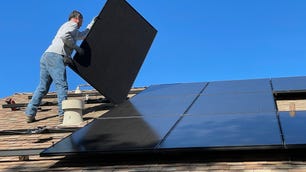A major solar panel manufacturer claims its latest cell technology can turn nearly a third of the solar energy that hits it into electricity. This cell is one and a third times as efficient as the best residential solar panel.
But if you’re shopping for solar panels for your home, you probably shouldn’t worry about it.
JinkoSolar’s perovskite tandem solar cell set a new efficiency record for its specific type of cell, the company announced last week.
The efficiency rating of 33.24% for an n-type TOPCon-based perovskite tandem cell seems miles ahead of the efficiency rating CNET reported on a few weeks ago when Maxeon announced its new most efficient solar panel the Maxeon 7, recording just under 25%.
Experts say, however, the two technologies are not the same and shouldn’t be compared. “Test results on new cells cannot be compared to the real-world efficiency of a currently available commercial panel, especially when they use very different technologies,” said Chuck Kutscher, lead author of Accelerating the US Clean Energy Transformation and contributing author to the 2020 Zero Carbon Action Plan by the United Nations Sustainable Development Solutions Network.
Kutscher, who also spent four decades as a renewable energy researcher at the National Renewable Energy Laboratory (NREL) said “the Jinko efficiency rating is just for an individual tandem cell consisting of two different cell designs.” The Maxeon 7’s 24.9% efficiency rating, he said, is for the entire panel with over 100 monocrystalline silicon solar cells wired together.
The Jinko tandem panel is made up of a perovskite layer. It lays on top of the monocrystalline silicon layer. It works by absorbing one part of the solar spectrum from the top layer while the monocrystalline silicon layer absorbs another part of the solar spectrum, said Kutscher.
“Stacking two different cells that collect different portions of the solar wavelength spectrum is a long-recognized way to boost efficiency, but it comes at a higher cost, and so the tandem design of this Jinko cell makes it more expensive than a single cell design typical of residential panels,” said Kutscher.
Perovskite cells like the one used in the Jinko Tandem Solar Cell don’t have the proven experience in the field and have not yet demonstrated the long-term durability of silicon cells, said Kutscher.

This is a close up look of a high performance solar cell made from a monocrystalline silicon wafer. The contact grid is made from busbars (large strip) and fingers (small strips). When light hits it it releases electrons, which are converted into an electrical current. A grid of wires collects the electrons. This is what a residential rooftop solar panel looks like.
The bottom line is, efficiency records for individual solar cells are broken all the time. Kutscher says it’s the efficiency, durability and cost of an entire solar panel that matter for residential installations. “It’s always encouraging to see new efficiency records set for different types of solar cells, but it can take a while for new cells to make it into successful commercial products, and they may never make that transition.”
Jinko does make a few different residential solar panels that are available for rooftops now. All have decently-high efficiency ratings just above 22%. CNET found the warranties to be mediocre, however.
For more information of which solar panel is the best or which panel is the most efficient CNET ranks and scores them for you based on criteria such as efficiency, temperature coefficient, wattage and warranty.
The Maxeon 7, the current reigning most efficient residential solar panel, is expected to be available in the US in the third quarter of 2024, the company said in a press release.






